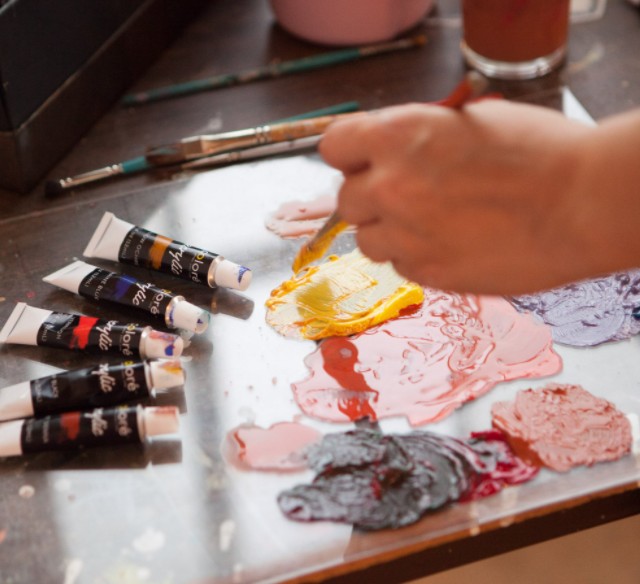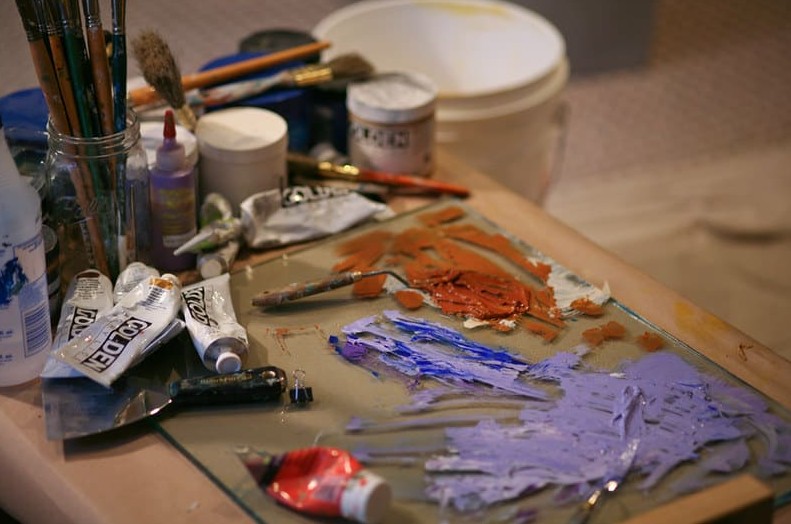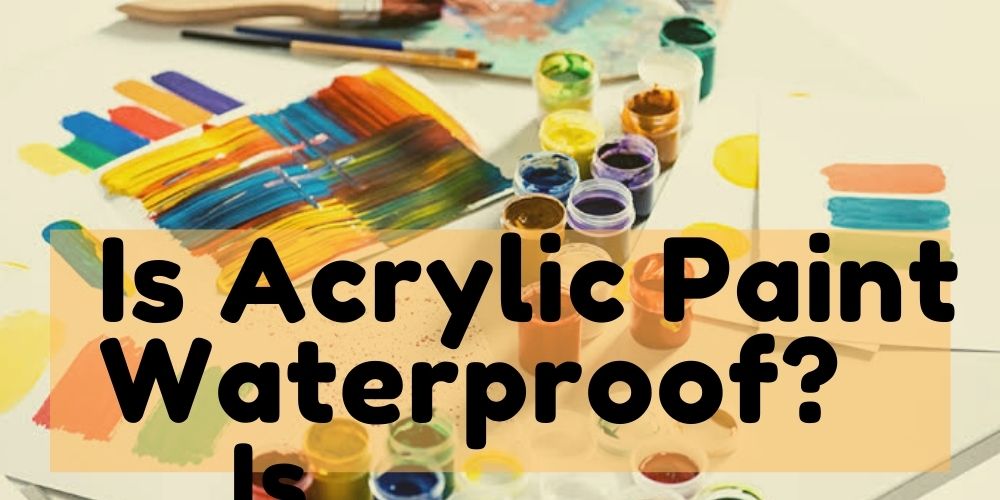Acrylic paints are versatile as you can perform various art activities with them. A common problem for most novice artists out there is they don’t know whether they should go with a fast-drying or slow-drying acrylic paint.
The majority of experts believe that the acrylic paint we use must not dry too slow or too fast; it should be medium. But, acrylic paints tend to dry quickly. Thin acrylic can dry in 15-20 minutes, whereas thick acrylic paint can dry within two to four hours.
Then how to make acrylic paint dry slower? Well, there are a few cool ways to do just that, and I will explain all the process here so that you can learn the art.

We have experimented with a few tricks on making acrylic paint dry slower, and you can check them out if you are looking for some good techniques to dry acrylic paint slowly.
How To Make Acrylic Paint Dry Slower (17 best Methods)
Acrylic paint dries quickly and will not offer room for changes. On the other hand, slow drying of acrylic paint can provide room for changes, and here’s how to make acrylic paint dry slower.
1. Using Acrylic Paint Retarder
The first and foremost step to slow the drying of an acrylic artwork is using an acrylic paint retarder. Many people also believe that acrylic paint retarders change the sheen of the paint, but it is only a myth because you only add a small amount of acrylic paint retarder.
Hence it will have zero impact on the painting. Golden 0003580-5 8 oz Acrylic Retarder is the best kind of retarder available in the market. We have used it and no doubt it does its job perfectly.
2. Make your Own Acrylic Paint Retarder
All you need is vegetable glycerin and water to make your acrylic paint retarder at home. Take a bowl to add vegetable glycerin and water in a 1:9 ratio. Once you find it consistent, you can add a small amount of mixture to the paint medium you will be using for the art project. You can also check out our article on how to make acrylic paint retarder on your own?
3. Planning and Sketching Before Painting
Well, You should never start painting before you have a plan in mind because once the paint is on the paper, you have no room for corrections. The other reason is it also dries very fast. Proper planning before painting will increase the painting time.
You can use it as much as you want before it dries. You can better draw a layout with a pencil and add acrylic paint later to ensure that you don’t make mistakes.
4. Painting In Proper Humidity
Make sure you’re painting in a relaxed environment, such as a basement or behind closed curtains. Drying time will be lengthened to prevent evaporation from occurring at high humidity levels (50 percent or above).
Instead, use a humidifier to keep things moist. Although an air conditioner or a fan may help cool the environment, if the humidity in your workplace is very high, the fan will only accelerate acrylic paint drying.
5. Set Up a Workplace with Less Air flow
The airflow inside the room will also play a crucial role when painting with acrylics. Although it is recommended to work in a shady place, you have to take care that the air flow inside the room is as low as possible. Less airflow ensures that it doesn’t dry your artwork quickly.

6. Check for the Temperature
Apart from the air-flow temperature also have a huge impact on the drying of the acrylic paint. Recent research also proved that a temperature of 16 degrees Celsius is perfect for acrylic paint. It should not dip below 9 degrees Celsius as it is considered as minimum film formation. You can either go in the early morning or late at night to perform artwork with acrylics.
7. Priming Surface Before Painting
Since the porous surface absorbs paint, it dries rapidly and requires several coats of paint to completely cover it. It’s crucial to use an acrylic primer and let it dry fully before painting to get a professional-looking result. To keep the paint from absorbing too rapidly, two coats should suffice. Gesso may be used to prime a variety of media, including wood, canvas, and paper.
8. Choosing Proper Palette Material
To begin with, standard food containers may be reused. To keep the paint from drying out for days, spray it with water before sealing the container. Any surface that does not absorb your paint like paper or wood is described as a “non-absorbent palette.” This might be glass, a tile, or something else entirely.
Palettes with special characteristics, like the Mijello Peel-Off Palette or a glass palette, are designed to keep your paints fresh for longer (they are pretty expensive for a palette).
9. Use Slow Drying Acrylic Mediums or Extender
Using a slow-drying acrylic medium or retarder with acrylics will ensure that it behaves more like oil paint which needs a long time to dry. The slow drying will ensure that you can make the best strokes and create smooth blending effects.

Are you looking for the best slow-drying acrylic medium or retarder in the market? Look no further than Winsor and Newton’s professional acrylic slow drying medium. One of the best advantages of using this acrylic medium is it offers no color shift from wet to dry.
10. Paint in Thick Layer
Heavy body acrylics play a vital role in acrylic painting as they have high viscosity when compared to normal acrylic paint; hence they act as buttery oils.
They are perfect for artists who love to play with textures and add amazing beauty to their artwork. Applying a thick layer of paint in acrylic will also ensure that paint doesn’t dry quickly.
11. Hydrate Your back Canvas
Spraying water on the back of your canvas is an excellent technique to keep your acrylics moist as they sit on your canvas. Spraying the back of your canvas provides a surface that is always wet, similar to the wet palette option, which slows down the drying period of your working surface.
Turn your canvas over to the back and apply a uniform spritz of water using a spray bottle filled with water. You’ll want to do this every few minutes (usually every 5-10 minutes) to keep your canvas damp but not saturated.
12. Opt For A Wet Pallet
If you’ve never heard of a wet palette, it’s just a tray with a moist surface for your acrylic paint to sit on while you work. Wet palette trays are a popular palette alternative because of the lovely walled edges that allow painters to put wet towels covered with parchment or tracing paper to help acrylic paint remain moist for longer.
This lets you work with a palette for many hours to days at a time, extending your paint total working time and avoiding the numerous problems that come with further color mixing.
13. Airtight Palette can be a good option
When painting with acrylics, you can use an airtight palette to store your artwork as it will constantly keep your painting in moisture, hence ensuring that it doesn’t get dried for days and a few weeks. You can shop for some of the best airtight palettes for acrylic paint for 10-15 USD.
14. Make your Own DIY Stay Wet Palette
Acrylic paint dries quickly; hence shopping for a commercial acrylic paint palette can be quite expensive hence. The best option available is you can make one on your own from household items. All you need is baking paper, a shallow white plate, a Kitchen towel, and water.
Cut the baking paper in such a way that it fits onto the plate, add water to the kitchen towel but don’t flood it, place the baking paper on the top of the kitchen towel, and add the paints to the plate.
15. Spraying Your Pallet As Per Need
The use of water on your palette is a simple yet effective means of keeping your paint moist. Fill your palette and paint pools halfway with water and spritz them with a spray of water every few minutes to keep them clean and ready to use.
Using this approach, you can keep your paint wet and functional for more extended periods while still keeping the convenience of setup and use.
16. Check For The Artist Grade Label
There are two types of paint: student and artist. The ratio of pigment and binder, or quality, is what sets them apart. We frequently assume that student-grade paint dries rapidly, and that the cheaper the color, the quicker it dries.
Although artist-grade paint lasts longer, it still dries swiftly. Artist quality paints include Deco Art Traditions Acrylic Paints, Pebeo Artists’ Acrylic Paints, Chroma Atelier Interactive Artists’ grade Acrylic Paints Utrecht Artists’ Acrylic Paints, and others.
17. Using Plastic Wrap
Using plastic wrap to airtight your pallet or container can be beneficial. You can also recycle any glass container from your kitchen and store your paint mixes safely in them. This will slow down the drying process at the time of painting.
Make sure to mist the paint mixes lightly with water and seal the lid of the container tightly before securing your paint for the next season.
Just follow these instructions properly, if you want your paint to last for many days to a week. To ensure that the seal on the lid is as tight as possible, cover the jar firmly using a plastic wrap prior to putting the cover on it to provide additional protection.
Best Acrylic Paint to Use for Longer Drying Times
You can try any one of the above ways to make acrylic paint dry slower. All the steps are very easy to follow and anyone can perform them without much trouble.
However, we can understand that it may be possible that you are low on time and need to speed up things a bit.
In that case, you may try the Golden Open Acrylic, simply because it is one of the best slow drying acrylic paints according to us.
I have also used it so I have no issue in recommending it to my readers.
Frequently Asked Questions (FAQs)
Get Your Answers Here
1. What’s the difference between acrylic extender and retarder?
A lot of people believe that acrylic extenders and retarders are different products but the main application of both the products is to extend the drying time of acrylic paint. Well, there is nothing to differentiate between extender and retarder. You have to find out which one works best for you.
2. How to make acrylic paint dry slower on canvas?
One of the best and easiest ways to make acrylic paint dry slower on canvas is by spraying a small amount of water behind the canvas. You can also use an airtight acrylic paint palette or learn how to make a DIY stay wet palette here.
Conclusion
Acrylic paints love to dry fast. We can say it is an advantage and a disadvantage depending on the type of your work. You can follow the above-mentioned ways to learn how to make acrylic paint dry slower comprehensively.
The increase in drying time will ensure that you can use different techniques and make your artwork even more creative and visually appealing.




